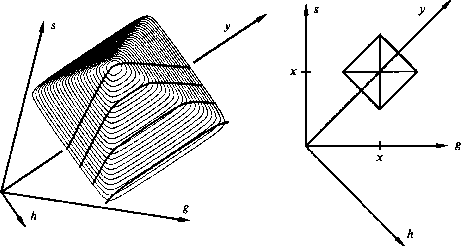 |
Figure 18 Left is a picture of the travel-time pyramid of equation
![[*]](http://sepwww.stanford.edu/latex2html/cross_ref_motif.gif) for fixed x and z.
The darkened lines are constant-offset sections.
Right is a cross section through the pyramid
for large t (or small z). (Ottolini)
for fixed x and z.
The darkened lines are constant-offset sections.
Right is a cross section through the pyramid
for large t (or small z). (Ottolini)
Because of the importance of the point-scatterer model, we will go to considerable lengths to visualize the functional dependence among t, z, x, s, and g in equation (5). This picture is more difficult--by one dimension--than is the conic section of the exploding-reflector geometry.
To begin with, suppose that the first square root in (5) is constant because everything in it is held constant. This leaves the familiar hyperbola in (g,t)-space, except that a constant has been added to the time. Suppose instead that the other square root is constant. This likewise leaves a hyperbola in (s,t)-space. In (s,g)-space, travel time is a function of s plus a function of g. I think of this as one coat hanger, which is parallel to the s-axis, being hung from another coat hanger, which is parallel to the g-axis.
A view of the travel-time pyramid on the (s,g)-plane or the (y,h)-plane is shown in Figure 18a.
 |
![[*]](http://sepwww.stanford.edu/latex2html/cross_ref_motif.gif) for fixed x and z.
The darkened lines are constant-offset sections.
Right is a cross section through the pyramid
for large t (or small z). (Ottolini)
for fixed x and z.
The darkened lines are constant-offset sections.
Right is a cross section through the pyramid
for large t (or small z). (Ottolini)
Notice that a cut through the pyramid at
large t is a square, the corners of which have been smoothed.
At very large t,
a constant value of t is the square contoured in (s,g)-space,
as in Figure 18b.
Algebraically, the squareness becomes evident for a point reflector
near the surface, say, ![]() .Then (5) becomes
.Then (5) becomes
| |
(6) |
More interesting and less obvious are the curves on common-midpoint gathers and constant-offset sections. Recall the definition that the midpoint between the shot and geophone is y. Also recall that h is half the horizontal offset from the shot to the geophone.
 |
(7) | |
| (8) |
For rays that are near the vertical, the travel-time curves are far from the hyperbola asymptotes. Then the square roots in (5) may be expanded in Taylor series, giving a parabola of revolution. This describes the eroded peak of the pyramid.